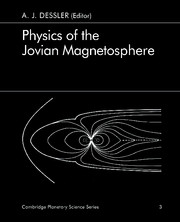Book contents
- Frontmatter
- Contents
- List of tables
- List of contributors
- Foreword
- Preface
- 1 Jupiter's magnetic field and magnetosphere
- 2 Ionosphere
- 3 The low-energy plasma in the Jovian magnetosphere
- 4 Low-energy particle population
- 5 High-energy particles
- 6 Spectrophotometric studies of the Io torus
- 7 Phenomenology of magnetospheric radio emissions
- 8 Plasma waves in the Jovian magnetosphere
- 9 Theories of radio emissions and plasma waves
- 10 Magnetospheric models
- 11 Plasma distribution and flow
- 12 Microscopic plasma processes in the Jovian magnetosphere
- Appendix A Symbols and acronyms
- Appendix B Coordinate systems
- Appendix C Jupiter and Io: selected physical parameters
- References
- Index
11 - Plasma distribution and flow
Published online by Cambridge University Press: 27 October 2009
- Frontmatter
- Contents
- List of tables
- List of contributors
- Foreword
- Preface
- 1 Jupiter's magnetic field and magnetosphere
- 2 Ionosphere
- 3 The low-energy plasma in the Jovian magnetosphere
- 4 Low-energy particle population
- 5 High-energy particles
- 6 Spectrophotometric studies of the Io torus
- 7 Phenomenology of magnetospheric radio emissions
- 8 Plasma waves in the Jovian magnetosphere
- 9 Theories of radio emissions and plasma waves
- 10 Magnetospheric models
- 11 Plasma distribution and flow
- 12 Microscopic plasma processes in the Jovian magnetosphere
- Appendix A Symbols and acronyms
- Appendix B Coordinate systems
- Appendix C Jupiter and Io: selected physical parameters
- References
- Index
Summary
The highly extended magnetic field-line configuration of the Jovian magnetosphere with a near-equatorial current sheet and associated plasma sheet arises from mechanical stresses in the rotating plasma balanced by magnetic stresses. The relative geometrical thinness of the current sheet permits the use of several approximations in the description of the stress balance, each with a specified regime of validity in terms of taillike vs. dipolar field and hot vs. cold plasma; these include pressure balance, a simplified tangential stress balance, and an estimate of current-sheet thickness. A number of simple but quantitative models of the magnetic field are now available, including both theoretical models based on various assumptions about the distribution and degree of corotation of the plasma and empirical models intended to represent the observations. From the empirical models, values of plasma parameters required to maintain stress balance can be estimated. To obtain agreement between the estimated and the observed mass density values, it is necessary to assume that the azimuthal velocity of the plasma decreases significantly below rigid corotation in the outer magnetosphere. The uncertainties in the magnetic field component normal to the current sheet lead to sizable discrepancies among various estimates of the density or of the current sheet thickness. Azimuthal magnetic fields over the midnight-to-dawn quadrant are nearly independent of local time, in contrast to the situation in the terrestrial magnetosphere; they imply radial currents whose closure through the ionosphere is related to partial corotation. Generalization of Parker-spiral arguments to include a finite ionospheric conductivity provides a quantitative model for the azimuthal field.
- Type
- Chapter
- Information
- Physics of the Jovian Magnetosphere , pp. 395 - 453Publisher: Cambridge University PressPrint publication year: 1983
- 390
- Cited by



